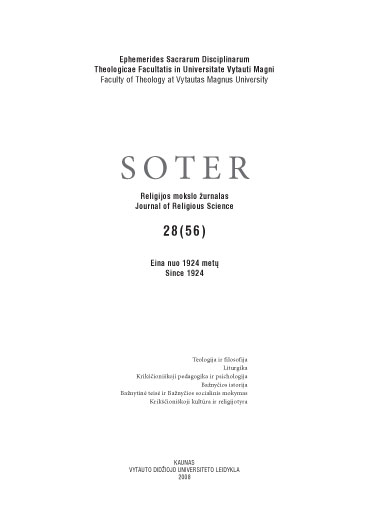Mergelės Marijos apsireiškimų traktuotė lietuvių folklore
APPARITIONS OF VIRGIN MARY IN LITHUANIAN FOLKLORE
Author(s): Aušra KairaitytėSubject(s): Christian Theology and Religion
Published by: Vytauto Didžiojo Universitetas
Keywords: Mergelė Marija; Dievo Motina; legendos; apsireiškimas; stebuklingi Marijos paveikslai; Virgin Mary; Mother of God; legends; apparition; sacred image of Mary.
Summary/Abstract: In Lithuania, we can find stories telling us about the apparitions of the Blessed Virgin Mary. Most of these stories are treated as folklore narratives. Such narratives can be found in various genres of Lithuanian folklore. In the article, the major attention is paid to the genre of legends. Lithuanian folklorist Leonardas Sauka the term “legend” defines as a narrative, containing magic, miraculous elements, but they are treated as true historical events, sacred stories related to religion and have an exclusive meaning in religious communities. In Lithuania and most European countries the main topic of such legends is Christianity. They tell us about Jesus Christ, Our Lady, apostles, saints, churches, miraculous places, religious beliefs and rituals. Traditionally the events are treated as true stories and people believe them. The author of the article does not intend to analyze these stories as true ones. The question of confirmation of sacred images in folk tradition and the problems of Mariology are also not considered. Legends are treated as a spoken creation of folk art, which describe the surrounding world and exceptional events. The object of the article is folklore narratives describing the apparitions of Mary. Some of these narratives in “Catalogue of Lithuanian narrative folklore” by Bronislava Kerbelytė are treated as legends. The basic narratives can be found in the Institute of Lithuanian Literature and Folklore Department of Folklore Archives. Published narratives are also analyzed. The aim is to describe the narratives about the apparition of Mary in Lithuanian folklore. The analysis of folk texts refers two conditional groups. In the first group of narratives, a personal apparition to a human person is represented by the direct appeal of Mary. The request to build a wooden cross or a chapel can indicate a sacred place and has the intention to cultivate religious feelings. This intention can be shown in the legends where Mary asks to pray and spread her words. It is common that people who saw an apparition of Mary just know that they saw Mary; sometimes they become scared, run away and start praying. Meanwhile, Mary explains who she is and gives a message. After the blessing, she goes away. In rare cases, a doubt that Mary really appeared can be expressed. However, it is more common to search the proofs of apparition. She can leave a foot on a stone, which is treated as a sign of her visitation. A boy who saw an apparition can become a saint. People visit a place of apparition and bring donations such as money to the place where Mary appeared. Usually Mary appears to children, women, or young men. Obviously, these people differ from other people by their social status. They can by treated as witnesses of an apparition and as those who can realize the will of Mary. The second group of narratives consists of legends about images that people treat as sacred. Mary’s miraculous power can be revealed through them. In general, people
Journal: SOTER: religijos mokslo žurnalas
- Issue Year: 56/2009
- Issue No: 28
- Page Range: 155-156
- Page Count: 11
- Language: Lithuanian

